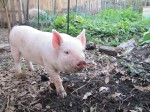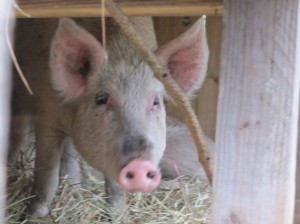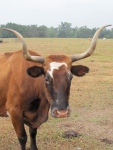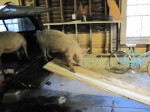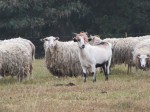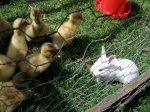I’ve been cheating on my New Orleans garden. And in my absence, she’s suffered. My ducks have gone feral, one of the beehives died, and the lot next door sold. I’ll explain more in depth about each of those three things, but first, I’ll explain where I’ve been.
I spent my summer trying to fulfill my lifelong dream of starting a summer camp. (You can read about it here). We made good progress for the first year (7 campers! Yay!) but it is going to be a climb for the next few years to get the word out and to actually get parents to pay to send their kids. But, success or failure, I still get to spend my summers from now on working alongside Albert (the baron of the bees), and spending 3 months on a 90 acre ranch in a ruggedly beautiful area of the west.  There are two nubian goats that we milk with the campers twice a day, 4 horses to ride, and cats and dogs to enjoy. There is also cattle raised for grass-fed beef, meat chickens raised on pasture and lots of pigs (and piglets!) to provide food for us and the camp. So, there’s many more animals to have fun with than I could or would ever want to fit into my urban life.
There are two nubian goats that we milk with the campers twice a day, 4 horses to ride, and cats and dogs to enjoy. There is also cattle raised for grass-fed beef, meat chickens raised on pasture and lots of pigs (and piglets!) to provide food for us and the camp. So, there’s many more animals to have fun with than I could or would ever want to fit into my urban life.

There’s also a huge garden, along with 100 mature blueberry bushes that we ate from and made jam for next year. And raspberries! And asparagus! Things we can’t grow in New Orleans! The ranch has many wonderful attributes, but it also has about nine months of winter, and at the height of winter, only 6 hours of sunlight. It’s also extremely remote and if you don’t really like the people you share it with, there aren’t many other options for social interaction.

So, at the end of camp, when I left to head back to New Orleans, I felt eager to return to my urban farmlet, but excited to plan for next summer too. And somehow, in my absence from New Orleans things have changed. I know that I have also changed, but so has New Orleans. I was greeted upon my return by Ferraris on Magazine St, celebrities squeezing me out of my wedding venue, and a subtle undertone of contempt among some acquaintances of,”so, living your dream. You suck.”
And my pet duck has gone crazy feral, and the person who I worked out a trade to check on my beehives over the summer didn’t do it, so one of the more established hives got overrun with wax moths and died. Lastly, the lot next door sold, but it’s a longer story than that. It not only sold, but it sold to a person who I’ve met a number of times. We share friends. He’s a huge proponent of this neighborhood and I figured he would build a house on the lot eventually, but I thought it would be worth approaching him about gardening on it in the meantime. So I sent him a friendly email about that possibility, only to get the response that no, he’s planning on farming the whole thing himself “a la a CSA”. Awesome. So, now I get to watch someone build a giant garden over the fence while they brag about how much they’ve helped the community. Gag.
So, I’ve tilled up the entire backyard behind the house, and moved the beehives, so now there’s a giant garden space. I’m slowly planting it and trying to tame what was a jungle but is now a dust bowl because I tilled in dry, dry, dry weather. Some day, I’ll have a nice garden back here again. But, sadly my days of pig farming in this neighborhood may be over – I’m out of room.

I haven’t updated my blog in the six weeks that I’ve been back because I’ve been trying to shed some positive light on what’s going on and have.
Unfortunately, I am not Anne of Green Gables. I haven’t figured out how to conquer every challenge presented to me with courageous optimism. My private urban oasis is gone – there’s construction workers leering down at me from balconies that surround the back yard and the air is punctuated with the sounds of progress from sun up to sun down. Good for the neighborhood but not so great for my life here. I think it might be time to find a new neighborhood.































